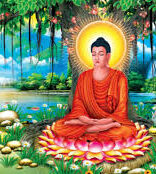
Spiritual tourism in India
Ditching the idea of visiting Hawaii or Niagara Falls, my freshly minted wife and I decided to devote our honeymoon to spiritual tourism. We had both been infected by the Buddhist virus years before, and the obvious choice for our mystical adventure was the pungent chaos of India, where the Buddha lived and died in the fifth and sixth centuries, BC. So we bought our tickets, got our shots, and, wanting to squeeze a drop or two of decadence out of the otherwise grueling experience of Indian travel, arranged for pleasant hotels and a car and driver.
Say what you will about Jerusalem, Tibet, or the Brazilian Amazon: There is no mightier destination for the spiritual tourist than India. The land offers a devotional feast: ceaseless festivals, Ramayana comic books, hash-smoking holy men with Rastafarian dreads, Hindu hard-liners running the government — even “Sacred Space” sections in the op-ed pages. No other country has spawned so many religions (Buddhism, Jainism, Sikhism, and the immense stew of cults and practices we broadly label “Hinduism”), while hosting so many more (Muslims, old school Christians, animists, even some ancient pockets of Jews). Hindus seem capable of worshipping just about anything, including trees, secular monuments, and the sacred spots of other faiths. They have also been peregrinating in their land for millennia, so you can be assured that everywhere you go, you will be surrounded by indigenous spiritual tourists.
Indeed, the Buddha himself encouraged the traveling trend. In an uncharacteristically self-mythologizing move, the dying man asked his followers to hit the road sometime in their life and visit four important places: his birthplace, his deathbed, the first place he preached, and the spot where he planted his ass for 49 days until the diamond mind of enlightenment dawned. Despite this injunction, homegrown Buddhists south of the Himalayas have been scarce ever since Turkish invaders stamped out the already dying embers of the religion a millennia ago. Though Chinese, Burmese, and Sinhalese Buddhists occasionally slogged through their Holy Land after the collapse of Indian Buddhism, the monasteries, stupas, and chaityas (worship halls) gradually disappeared.
Nowadays the “Buddhist Circuit” — as the roadsigns delightfully proclaim — is bouncing back. After a century of slow development, the Circuit has kicked into overdrive, and now presents an essentially modern phenomenon: a complex product of archaeology, tourist ministries, modern infrastructure, national pride, and 20th-century Buddhist reform movements. For spiritual tourists like us, straddling globalized sightseeing and genuine pilgrimage, nothing could be finer.
Bodh Gaya, the hamlet that commemorates the spot where Prince Siddhartha sat down beneath a pipal tree and became the Buddha, is one of the Circuit’s finest destinations. By the 14th century, the town’s main Mahabodi temple was already an internationalist bricolage, two millennia worth of Ashokan railings, Bengali vihara (monasteries), Burmese reconstructions, Chinese inscriptions, and myriad traveler’s stupas. But floods and neglect covered up the spot until the late 19th century, when the British archaeologist Alexander Cunningham took charge of restoring the temple grounds. Soon after, the influential Buddhist reformer Anagarika Dharmapala took up the cause.
Dharmapala’s efforts eventually succeeded, and today Bodh Gaya is a kind of internationalist Dharmaland. Wandering the streets that cluster around the beautiful grounds of the Mahabodhi temple, you stumble upon temples and monasteries from Vietnam, Thailand, Japan, Nepal, Tibet, China, and Bhutan, each done up in its own characteristic national style. Indeed, you get the
impression that a sort of architectural arms race is afoot, as each new temple strives to outdo its neighbors in opulence and ornamental devotion: Bhutan’s brand-spanking new temple visibly incarnated psychedelia with its neon color schemes, visionary images, and 3D stucco designs. Bodh Gaya’s temple row creates an ideal situation for the spiritual tourist, who can shuffle through the major pockets of Asian Buddhism in an afternoon, bowing or meditating wherever the spirit strikes.
Bodh Gaya is not yet a Buddhist Epcot Center, although the number of hotels and temples popping up is unnerving for folks who like their religion hallowed with age, if not wracked with ruin. At the same time, the global diversity of the town affirms how curiously the dharma has crept through the world. Virus-like, Buddhism burned out its original host but propagated itself through various surrounding cultures, transforming indigenous material (shamanism in Tibet, Taoism in China) rather than simply blanketing it with foreign rite and ideology. Slowly mutating, and rarely depending on violence, the spread of dharma was organic — more “bottom-up” than “top-down,” certainly when compared to the sword-wielding evangelism practiced by the Muslims who made India their prize.
The organic roots of Buddhism curl through the Mahabodhi temple as well. The power spot here is not the inner sanctum, where you will find a saffron-robed Buddha whose mystical halo has been brought to life by a low-tech Las Vegas of colored lights. The real sacred action lies outside: Around back, a huge pipal tree thrusts from the soil on a raised platform. This is the Buddha’s bo tree, draped with raggedy prayer flags and wrapped with ribbons, its bark worn and oily from the hands of countless pilgrims. Its farflung limbs form a canopy over a global stream of worshippers, but these limbs now rely on a handful of struts to support them. In a flash it struck me how fit a metaphor this made for the religion itself, whose existential refuge depends upon the continuous practice of those who strive to come in from the storm.
Elsewhere on the Buddhist Circuit, the support structures were a bit more prosaic: hotels, fresh roads, new temples, restaurants — even a ski lift that takes you to the bright and shiny Vishwa Shanti stupa in the hills above Rajgir. The Japanese have been particularly busy, pouring tons of money into the region and creating an infrastructure packaged by foreign sects, private companies, and the Ministry of Tourism into a tasty morsel for pilgrims. The development plan is working — tourist dollars pouring into Bihar, a poor state that includes much of the Circuit, nearly doubled between 1997 and 1998. (Caucasians are still refreshingly rare, although they are featured prominently in the photos for the Ministry of Tourism’s snazzy Walking with the Buddha guidebook.)
As we made our way through the Circuit, we kept running into three different, seemingly representative tour groups. Most absurd was a massive pack of well-heeled Thais, who cruised around in three monstrous air-conditioned buses, with a fourth bus set aside for their leather luggage and Timberland bags. They did not practice meditation. On the other end of the spectrum was a handful of white-clad Sri Lankans who were clearly on a mystical roll: They meditated everywhere and performed elaborate ceremonies with fire, while their female teacher, who they called “Mother,” wore a tuque and a mysterious grin. But our favorite crew was a large Sri Lankan contingent of old ladies, who papered every crumbling stupa with flags, flowers, and incense while their handlers videotaped the proceedings for souvenir cassettes. They even videotaped us; translocal color, I suppose.
Perhaps most moving was the Jetavana park at Sravasti, where the Buddha and crew hunkered down for 25 rainy seasons. Though populated by a particularly insidious pack of conniving local boys, the beautifully landscaped park achieved the perfect balance of recent upkeep and timeless disarray. Dusk fell, and with it a heavy peace. India shows its most enchanting face at twilight, and the air was thick with its ancient honey. A shrouded monk in scarlet robes sat meditating before the lotus tank, and his intense practice almost seemed to sustain the place. One of the camera fellows with the Sri Lankan group gave me the skinny on the solitary monk. Apparently, he was French.
Although this Gallic bhikkhu may have made a clean spiritual crossover from the post-Christian West, I found myself still rather unsure about where I stood. In Zen they speak of “patch-robed monks”; my wife and I were crazy-quilt Americans. Certainly we plugged into the Buddhist Circuit to gain a new perspective on the dharma, to “deepen our practice.” But we were also outsiders, spiritual tourists. We sought insight, but we were also on a quest for the tackiest dharma kitsch we could find, a quest that was satisfied by chintzy holographic keychains (“shining Buddha” we were told) and a set of plastic dinner plates smeared with fuzzy photo-transfers of Tibetan mandalas.
The question raised itself most forcefully when I was wandering around the Mahabodhi temple: In what sense do folks like us share the same path as these young Tibetans ceaselessly prostrating themselves on wooden boards? Here were all the religious elements overlooked by many Western practitioners: ritual piety, supernatural lore, mythological narrative. At that moment, I wanted to express my gratitude for all the marvels the dharma has brought into my fractured ken. But how? Should I ape historically constructed behavioral gestures developed in places I’ve never been or lapse back into anthropologist mode? Should I hit the record button on my carefully concealed Sony minidisc machine or find my own, hesitant voice? The spiritual tourist was anxious.
But I also knew that, according to the fellow who started it all, anxiety was the inevitable weight of the baggage we all carry — the baggage of “self.” Devotional acts are not necessarily robotic or superstitious; they can also draw the suffering self out of its insidious self-concern. In a way, I was fortunate to have nothing to fall back on, no prayers or comfortable moves. All I could offer was attention itself, the raw awareness of my little evanescent slice of space-time: the heat, the babble of polyglot prayer, the heft of my Rajasthani handbag, all infused with the unbidden intention to cut to the bone of the moment. That was offering enough.
First appeared in Feed




